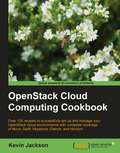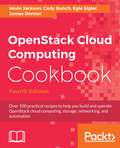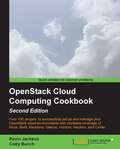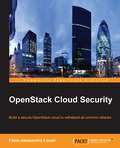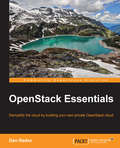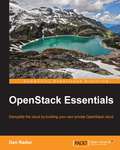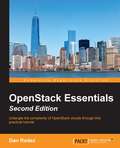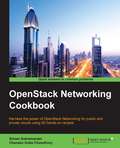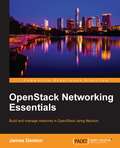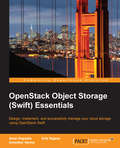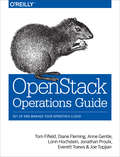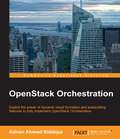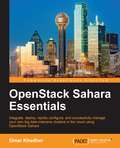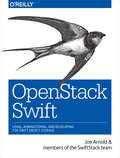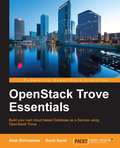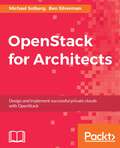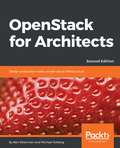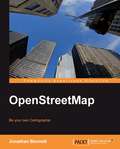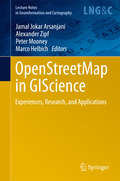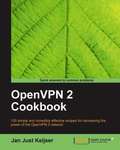- Table View
- List View
OpenStack Cloud Computing Cookbook
by Kevin JacksonA Cookbook full of practical and applicable recipes that will enable you to use the full capabilities of OpenStack like never before. This book is aimed at system administrators and technical architects moving from a virtualized environment to cloud environments with familiarity of cloud computing platforms. Knowledge of virtualization and managing linux environments is expected.
OpenStack Cloud Computing Cookbook - Fourth Edition: Over 100 practical recipes to help you build and operate OpenStack cloud computing, storage, networking, and automation
by Cody Bunch Kevin Jackson James Denton Egle SiglerThe Fourth Edition of the industry-acclaimed OpenStack Cloud Computing Cookbook, from four recognized experts, updated to the latest OpenStack build including Cinder, Nova, and Neutron. Key Features Over 100 recipes created by a team of OpenStack experts Updated to work with the latest OpenStack builds, with recipes covering the installation and use of OpenStack with Ansible It covers topics such as Keystone, Glance, Neutron, Nova, Cinder, and more, plus recipes for OpenStack storage, networking, and orchestrating workloads Test drive OpenStack using the accompanying Vagrant environment Book Description This is the fourth edition of the industry-acclaimed OpenStack Cloud Computing Cookbook, created by four recognized OpenStack experts. It has now been updated to work with the latest OpenStack builds, using tools and processes based on their collective and vast OpenStack experience. OpenStack Open Source Cloud software is one of the most used cloud infrastructures to support a wide variety of use cases, from software development to big data analysis. It is developed by a thriving community of individual developers from around the globe and backed by most of the leading players in the cloud space today. We make it simple to implement, massively scalable, and able to store a large pool of data and networking resources. OpenStack has a strong ecosystem that helps you provision your cloud storage needs. Add OpenStack's enterprise features to reduce the cost of your business. This book will begin by showing you the steps to build up an OpenStack private cloud environment using Ansible. You'll then discover the uses of cloud services such as the identity service, image service, and compute service. You'll dive into Neutron, the OpenStack Networking service, and get your hands dirty with configuring networks, routers, load balancers, and more. You’ll then gather more expert knowledge on OpenStack cloud computing by managing your cloud's security and migration. After that, we delve into OpenStack Object storage and you’ll see how to manage servers and work with objects, cluster, and storage functionalities. Finally, you will learn about OpenStack dashboard, Ansible, Keystone, and other interesting topics. What you will learn Understand, install, configure, and manage a complete OpenStack Cloud platform using OpenStack-Ansible Configure networks, routers, load balancers, and more with Neutron Use Keystone to setup domains, roles, groups and user access Learn how to use Swift and setup container access control lists Gain hands-on experience and familiarity with Horizon, the OpenStack Dashboard user interface Automate complete solutions with our recipes on Heat, the OpenStack Orchestration service as well as using Ansible to orchestrate application workloads Follow practical advice and examples to run OpenStack in productionWho this book is for This book is written for cloud system engineers, system administrators, and technical architects who are moving from a virtualized environment to cloud environments. This book assumes that you are familiar with cloud computing platforms, and have knowledge of virtualization, networking, and managing Linux environments.
OpenStack Cloud Computing Cookbook - Third Edition
by Cody Bunch Kevin JacksonThis book is aimed at cloud system engineers, system administrators, and technical architects who are moving from a virtualized environment to cloud environments. This book assumes that you are familiar with cloud computing platforms, and have knowledge of virtualization, networking, and managing Linux environments.
OpenStack Cloud Computing Cookbook Fourth Edition: Over 100 Practical Recipes To Help You Build And Operate Openstack Cloud Computing, Storage, Networking, And Automation
by Cody Bunch Kevin Jackson James Denton Egle SiglerKey Features Over 100 recipes created by a team of OpenStack experts Updated to work with the latest OpenStack builds, with recipes covering the installation and use of OpenStack with Ansible It covers topics such as Keystone, Glance, Neutron, Nova, Cinder, and more, plus recipes for OpenStack storage, networking, and orchestrating workloads Test drive OpenStack using the accompanying Vagrant environment Book Description This is the fourth edition of the industry-acclaimed OpenStack Cloud Computing Cookbook, created by four recognized OpenStack experts. It has now been updated to work with the latest OpenStack builds, using tools and processes based on their collective and vast OpenStack experience. OpenStack Open Source Cloud software is one of the most used cloud infrastructures to support a wide variety of use cases, from software development to big data analysis. It is developed by a thriving community of individual developers from around the globe and backed by most of the leading players in the cloud space today. We make it simple to implement, massively scalable, and able to store a large pool of data and networking resources. OpenStack has a strong ecosystem that helps you provision your cloud storage needs. Add OpenStack's enterprise features to reduce the cost of your business. This book will begin by showing you the steps to build up an OpenStack private cloud environment using Ansible. You'll then discover the uses of cloud services such as the identity service, image service, and compute service. You'll dive into Neutron, the OpenStack Networking service, and get your hands dirty with configuring networks, routers, load balancers, and more. You'll then gather more expert knowledge on OpenStack cloud computing by managing your cloud's security and migration. After that, we delve into OpenStack Object storage and you'll see how to manage servers and work with objects, cluster, and storage functionalities. Finally, you will learn about OpenStack dashboard, Ansible, Keystone, and other interesting topics. <P><P>What you will learn <P><P>Understand, install, configure, and manage a complete OpenStack Cloud platform using OpenStack-Ansible <P><P>Configure networks, routers, load balancers, and more with Neutron <P><P>Use Keystone to setup domains, roles, groups and user access <P><P>Learn how to use Swift and setup container access control lists <P><P>Gain hands-on experience and familiarity with Horizon, the OpenStack Dashboard user interface <P><P>Automate complete solutions with our recipes on Heat, the OpenStack Orchestration service as well as using Ansible to orchestrate application workloads <P><P>Follow practical advice and examples to run OpenStack in production
OpenStack Cloud Computing Cookbook, Second Edition
by Cody Bunch Kevin JacksonA Cookbook full of practical and applicable recipes that will enable you to use the full capabilities of OpenStack like never before.This book is aimed at system administrators and technical architects moving from a virtualized environment to cloud environments with familiarity of cloud computing platforms. Knowledge of virtualization and managing linux environments is expected.
OpenStack Cloud Security
by Fabio Alessandro LocatiIf you are an OpenStack administrator or developer, or wish to build solutions to protect your OpenStack environment, then this book is for you. Experience of Linux administration and familiarity with different OpenStack components is assumed.
OpenStack Essentials
by Dan RadezIf you need to get started with OpenStack or want to learn more, then this book is your perfect companion. If you're comfortable with the Linux command line, you'll gain confidence in using OpenStack.
OpenStack Essentials
by Dan Radez<P><P>Demystify the cloud by building your own private OpenStack cloud <P><P>About This Book <P><P>Set up a powerful cloud platform using OpenStack <P><P>Learn about the components of OpenStack and how they interact with each other <P><P>Follow a step-by-step process that exposes the inner details of an OpenStack cluster <P><P>Who This Book Is For <P><P>If you need to get started with OpenStack or want to learn more, then this book is your perfect companion. If you're comfortable with the Linux command line, you'll gain confidence in using OpenStack. <P><P>What You Will Learn <P><P>Install OpenStack using the Packstack installation tool <P><P>Create users, cloud images, and virtual networks to launch cloud instances <P><P>Explore horizontal scaling to support the load that a cloud platform is expected to handle <P><P>Set up monitoring to keep track of the health of an OpenStack cloud <P><P>Troubleshoot issues with an OpenStack cluster <P><P>Build storage and access it from your running cloud instances <P><P>Orchestrate a multi-instance deployment to build a complex set of virtual infrastructure to run an application in the cloud <P><P>Keep track of resources being consumed within an OpenStack cloud through metering <P><P>In Detail <P><P>An OpenStack cloud is a complex jungle of components that can speed up managing a virtualization platform. Applications that are built for this platform are resilient to failure and convenient to scale. OpenStack allows administrators and developers to consolidate and control pools of compute, networking, and storage resources, with a centralized dashboard and administration panel to enable the large-scale development of cloud services. <P><P>Begin by exploring and unravelling the internal architecture of the OpenStack cloud components. After installing the RDO distribution, you will be guided through each component via hands-on exercises, learning more about monitoring and troubleshooting the cluster. By the end of the book, you'll have the confidence to install, configure, and administer an OpenStack cloud. <P><P>This is a practical and comprehensive tutorial on sorting out the complexity of an OpenStack cloud.
OpenStack Essentials - Second Edition
by Dan RadezUntangle the complexity of OpenStack clouds through this practical tutorial About This Book * Navigate through the complex jungle of components in OpenStack using practical instructions * This book helps administrators, cloud engineers, and even developers to consolidate and control pools of compute, networking, and storage resources * Learn to use the centralized dashboard and administration panel to monitor large-scale deployments Who This Book Is For This book is perfect for administrators, cloud engineers, and operators who want to get started with OpenStack, solve basic problems encountered during deployment, and get up to speed with the latest release of OpenStack. Familiarity with the Linux command line and experience with Linux system administration is expected. What You Will Learn * Brush up on the latest release, and how it affects the various components * Install OpenStack using the Packstack and RDO Manager installation tool * Learn to convert a computer node that supports Docker containers * Implement Ceph Block Device images with OpenStack * Create and allocate virtual networks, routers and IP addresses to OpenStack Tenants. * Configuring and Launching a Docker container. In Detail OpenStack is a widely popular platform for cloud computing. Applications that are built for this platform are resilient to failure and convenient to scale. This book, an update to our extremely popular OpenStack Essentials (published in May 2015) will help you master not only the essential bits, but will also examine the new features of the latest OpenStack release - Mitaka; showcasing how to put them to work straight away. This book begins with the installation and demonstration of the architecture. This book will tech you the core 8 topics of OpenStack. They are Keystone for Identity Management, Glance for Image management, Neutron for network management, Nova for instance management, Cinder for Block storage, Swift for Object storage, Ceilometer for Telemetry and Heat for Orchestration. Further more you will learn about launching and configuring Docker containers and also about scaling them horizontally. You will also learn about monitoring and Troubleshooting OpenStack. Style and approach This book offers step-by-step practical instructions to help you quickly navigate through the complexities of OpenStack
OpenStack Networking Cookbook
by Sriram Subramanian Chandan Dutta ChowdhuryThis book is aimed at network and system administrators who want to deploy and manage OpenStack-based cloud and IT infrastructure. If you have basic knowledge of OpenStack and virtualization, this book will help you leverage the rich functionality of OpenStack Networking in your cloud deployments.
OpenStack Networking Essentials
by James DentonBuild and manage networks in OpenStack using Neutron About This Book * Deploy an all-in-one cloud based on OpenStack Liberty (2015.2) using RDO * Learn the fundamentals of the Neutron API including networks, subnets, and ports, and how to manage these resources in the cloud * Build simple virtual network infrastructures in the cloud Who This Book Is For The book is for those who are new to OpenStack and Neutron who want to learn the cloud networking fundamentals and get started with OpenStack networking. Prior networking experience along with a virtual or physical server is recommended to follow along with the concepts demonstrated in the book. What You Will Learn * Install the latest Liberty (2015.2) release of OpenStack using RDO in VirtualBox * Discover the basics of the Neutron API, including networks, subnets, and ports * Interact with Neutron using the CLI and Horizon dashboard * Create networks and subnets that provide connectivity to instances * Implement software routers that connect networks and provide network address translation * Secure instances using Neutron's security group functionality In Detail The OpenStack Networking API offers users the ability to create and manage both basic and complex network architectures that blend the virtual and physical network infrastructure. This book kicks off by describing various components of Openstack Neutron and installing Ubuntu OpenStack based on Canonical's process. Further on, you will use various methods to interface with Neutron to create and manage network resources. You will also get to grips with the relationship between ports, networks, and subnets through diagrams and explanations, and see how the logical components are implemented via plugins and agents. Moving forward, you will learn how virtual switches are implemented and how to build Neutron routers. You will also configure networks, subnets, and routers to provide connectivity to instances using simple examples. At the end, you will configure and manage security groups, and will observe how these rules translate to iptables rules on the host machines. By the end of the book, you will be able to build basic network architectures using Neutron networks and routers in no time. Style and approach An easy-to-follow guide that covers the networking features of OpenStack and the core Neutron API components providing a solid foundation to deploy networks and instances.
OpenStack Object Storage (Swift) Essentials
by Kris Rajana Amar KapadiaIf you are an IT administrator and you want to enter the world of cloud storage using OpenStack Swift, then this book is ideal for you. Basic knowledge of Linux and server technology is beneficial to get the most out of the book.
OpenStack Operations Guide: Set Up and Manage Your OpenStack Cloud
by Anne Gentle Jonathan Proulx Lorin Hochstein Joe Topjian Tom Fifield Diane Fleming Everett ToewsDesign, deploy, and maintain your own private or public Infrastructure as a Service (IaaS), using the open source OpenStack platform. In this practical guide, experienced developers and OpenStack contributors show you how to build clouds based on reference architectures, as well as how to perform daily administration tasks.Designed for horizontal scalability, OpenStack lets you build a cloud by integrating several technologies. This approach provides flexibility, but knowing which options to use can be bewildering. Once you complete this book, you’ll know the right questions to ask while you organize compute, storage, and networking resources. If you already know how to manage multiple Ubuntu machines and maintain MySQL, you’re ready to:Set up automated deployment and configurationDesign a single-node cloud controllerUse metrics to improve scalabilityExplore compute nodes, network design, and storageInstall OpenStack packagesUse an example architecture to help simplify decision-makingBuild a working environment to explore an IaaS cloudManage users, projects, and quotasTackle maintenance, debugging, and network troubleshootingMonitor, log, backup, and restore
OpenStack Orchestration
by Adnan Ahmed SiddiquiExploit the power of dynamic cloud formation and auto-scaling features to fully implement OpenStack orchestrationAbout This BookSet up, manage, and troubleshoot Heat and effectively automate your datacenter and cloud-based servicesAchieve high availability, minimize down-time, and automate the deployment of cloud-based services and resources with minimum effortUpgrade your skills and manipulate resources on virtual machines in an unattended fashion using HeatWho This Book Is ForIf you are a System Engineer, System Administrator, Cloud Administrator, or a Cloud Engineer, then this book is for you. You should have a background of working in a Linux-based setup. Any knowledge of OpenStack-based cloud infrastructure will help you create wonders using this book.What You Will LearnInstall an orchestration service for a private cloud environmentTackle errors that show up during the installation and configuration of heatConfigure a template for orchestration using the native HOT formatConfigure a template for orchestration using the AWS cloud formation formatDeploy a stack using the HOT templateDeploy a test stack using the AWS CloudFormation templateAutomate and orchestrate cloud-based services with OpenStack HeatIn DetailThis book is focused on setting up and using one of the most important services in OpenStack orchestration, Heat. First, the book introduces you to the orchestration service for OpenStack to help you understand the uses of the templating mechanism, complex control groups of cloud resources, and huge-potential and multiple-use cases. We then move on to the topology and orchestration specification for cloud applications and standards, before introducing the most popular IaaS cloud framework, Heat. You will get to grips with the standards used in Heat, overview and roadmap, architecture and CLI, heat API, heat engine, CloudWatch API, scaling principles, JeOS and installation and configuration of Heat. We wrap up by giving you some insights into troubleshooting for OpenStack.With easy-to-follow, step-by-step instructions and supporting images, you will be able to manage OpenStack operations by implementing the orchestration services of Heat.Style and approachThe book is a step-by-step guide to implementing an orchestration (cloud formation) service for OpenStack-based cloud environments. This book uses real-world scenarios and examples to demonstrate the procedures in an easy-to-understand language with plenty of screenshots to help you get a better understanding.
OpenStack Sahara Essentials
by Omar KhedherIntegrate, deploy, rapidly configure, and successfully manage your own big data-intensive clusters in the cloud using OpenStack Sahara About This Book * A fast paced guide to help you utilize the benefits of Sahara in OpenStack to meet the Big Data world of Hadoop. * A step by step approach to simplify the complexity of Hadoop configuration, deployment and maintenance. Who This Book Is For This book targets data scientists, cloud developers and Devops Engineers who would like to become proficient with OpenStack Sahara. Ideally, this book is well suitable for readers who are familiars with databases, Hadoop and Spark solutions. Additionally, a basic prior knowledge of OpenStack is expected. The readers should also be familiar with different Linux boxes, distributions and virtualization technology. What You Will Learn * Integrate and Install Sahara with OpenStack environment * Learn Sahara architecture under the hood * Rapidly configure and scale Hadoop clusters on top of OpenStack * Explore the Sahara REST API to create, deploy and manage a Hadoop cluster * Learn the Elastic Processing Data (EDP) facility to execute jobs in clusters from Sahara * Cover other Hadoop stable plugins existing supported by Sahara * Discover different features provided by Sahara for Hadoop provisioning and deployment * Learn how to troubleshoot OpenStack Sahara issues In Detail The Sahara project is a module that aims to simplify the building of data processing capabilities on OpenStack. The goal of this book is to provide a focused, fast paced guide to installing, configuring, and getting started with integrating Hadoop with OpenStack, using Sahara. The book should explain to users how to deploy their data-intensive Hadoop and Spark clusters on top of OpenStack. It will also cover how to use the Sahara REST API, how to develop applications for Elastic Data Processing on Openstack, and setting up hadoop or spark clusters on Openstack. Style and approach This book takes a step by step approach teaching how to integrate, deploy and manage data using OpenStack Sahara. It will teach how the OpenStack Sahara is beneficial by simplifying the complexity of Hadoop configuration, deployment and maintenance.
OpenStack Swift
by Joe ArnoldGet up and running with OpenStack Swift, the free, open source solution for deploying high-performance object storage clusters at scale. In this practical guide, Joe Arnold, co-founder and CEO of SwiftStack, brings you up-to-speed on the basic concepts of object storage and walks you through what you need to know to plan, build, operate, and measure the performance of your own Swift storage system.Object storage is essential today with the growth of web, mobile, and software-as-a-service (SaaS) applications. This book helps you through the process, with separate sections on application development, installation, administration, and troubleshooting.Learn Swift's concepts for organizing, distributing, and serving dataExplore basic and advanced features of the Swift RESTful APIDelve into Swift's many client libraries, including useful Python featuresWrite middleware to customize and simplify your storage systemUnderstand requirements for planning a Swift deployment--including your specific use caseLearn options for coaxing the best performance from your clusterGet best practices for daily operations, such as monitoring and planning capacity additionsPick up techniques for testing and benchmarking your Swift cluster
OpenStack Trove
by Amrith Kumar Douglas ShelleyOpenStack Trove is your step-by-step guide to set up and run a secure and scalable cloud Database as a Service (DBaaS) solution. The book shows you how to set up and configure the Trove DBaaS framework, use prepackaged or custom database implementations, and provision and operate a variety of databases--including MySQL, PostgreSQL, MongoDB, Cassandra, and Redis--in development and production environments. Authors Amrith Kumar and Douglas Shelley, both active technical contributors to the Trove project, describe common deployment scenarios such as single-node database instances and walk you through the setup, configuration, and ongoing management of complex database topics like replication, clustering, and high availability. The book provides detailed descriptions of how Trove works and gives you an in-depth understanding of its architecture. It also shows you how to avoid common errors and debug and troubleshoot Trove installations, and perform common tasks such as: What you'll learn Install and configure Trove Install preconfigured database technologies or guest images Launch database instances using Trove Perform common administrative tasks Resize and reconfigure database instances Take backups, and launch instances from existing backups Manage groups of database instances with configuration groups Debug and troubleshoot a Trove installation Set up replication and clustering Build custom guest images for use with Trove Who this book is for OpenStack Trove is targeted at a broad spectrum of readers, including software engineers seeking development agility with database-driven applications, devops engineers tasked with operating a database infrastructure with numerous databases, and data analysts looking to improve velocity by being able to quickly provision and release database capacity. Table of Contents 1 An introduction to Database-as-a-Service 2 Downloading and Installing OpenStack Trove 3 Basic Trove Operations 4 OpenStack Trove Concepts and Architecture 5 Advanced Trove configurations and operations 6 Debugging and Troubleshooting 7 Building custom guest images 8 Trove Configuration Files 9 Trove Quick Reference 10 Trove API 11 Trove Orchestration
OpenStack Trove Essentials
by Alok Shrivastwa Sunil SaratBuild your own cloud based Database as a Service using OpenStack Trove About This Book * Familiarize yourself with the concept of Database as a Service and make your existing system scalable and efficient with OpenStack Trove * Minimize the administrative tasks and complexities of managing your cloud infrastructure * This is a fast-paced guide to datastore management on the OpenStack platform using OpenStack Trove Who This Book Is For If you are a DBA / system administrator / architect, or a student who wants to build a Database as a Service based on OpenStack, this book is for you. You should have a basic knowledge of OpenStack components, RDBMS/NoSQL, IaaS, and cloud computing. What You Will Learn * Get to grips with the basics of OpenStack and the prerequisites to install Trove * Understand the expectations of DBaaS and how Trove can help you achieve them * Set up a basic installation of DevStack (Development Stack) in a virtual box * Install Trove and utilize its configuration groups to manage and tune databases * Use Image builder to create guest images for Trove * Utilize Trove to provision your first database instance * Back up and restore your databases with the help of Trove In Detail OpenStack has become an extremely popular solution to build public and private clouds with. Database as a Service (DBaaS) enables the delivery of more agile database services at lower costs. Some other benefits of DBaaS are secure database deployments and compliance to standards and best practices. Trove is a DBaaS built on OpenStack and is becoming more popular by the day. Since Trove is one of the most recent projects of OpenStack, DBAs and system administrators can find it difficult to set up and run a DBaaS using OpenStack Trove. This book helps DBAs make that step. We start by introducing you to the concepts of DBaaS and how is it implemented using OpenStack Trove. Following this, we look at implementing OpenStack and deploying Trove. Moving on, you will learn to create guest images to be used with Trove. We then look at how to provision databases in self-service mode, and how to perform administration tasks such as backup and recovery, and fine-tuning databases. At the end of the book, we will examine some advanced features of Trove such as replication. Style and approach This fast-paced, step-by-step guide introduces you to DBaaS, OpenStack Trove, and its components, leading you through building your own Cloud-based DBaaS. Using the DevStack deployment method, you will spend less time on installing OpenStack so you can devote more time to learning how to provision and manage databases in a DBaaS environment.
OpenStack for Architects
by Ben Silverman Michael SolbergDesign and implement successful private clouds with OpenStack About This Book • Explore the various design choices available for cloud architects within an OpenStack deployment • Craft an OpenStack architecture and deployment pipeline to meet the unique needs of your organization • Create a product roadmap for Infrastructure as a Service in your organization using this hands-on guide Who This Book Is For This book is written especially for those who will design OpenStack clouds and lead their implementation. These people are typically cloud architects, but may also be in product management, systems engineering, or enterprise architecture. What You Will Learn • Familiarize yourself with the components of OpenStack • Build an increasingly complex OpenStack lab deployment • Write compelling documentation for the architecture teams within your organization • Apply Agile configuration management techniques to deploy OpenStack • Integrate OpenStack with your organization's identity management, provisioning, and billing systems • Configure a robust virtual environment for users to interact with • Use enterprise security guidelines for your OpenStack deployment • Create a product roadmap that delivers functionality quickly to the users of your platform In Detail Over the last five years, hundreds of organizations have successfully implemented Infrastructure as a Service (IaaS) platforms based on OpenStack. The huge amount of investment from these organizations, industry giants such as IBM and HP, as well as open source leaders such as Red Hat have led analysts to label OpenStack as the most important open source technology since the Linux operating system. Because of its ambitious scope, OpenStack is a complex and fast-evolving open source project that requires a diverse skill-set to design and implement it. This guide leads you through each of the major decision points that you'll face while architecting an OpenStack private cloud for your organization. At each point, we offer you advice based on the experience we've gained from designing and leading successful OpenStack projects in a wide range of industries. Each chapter also includes lab material that gives you a chance to install and configure the technologies used to build production-quality OpenStack clouds. Most importantly, we focus on ensuring that your OpenStack project meets the needs of your organization, which will guarantee a successful rollout. Style and approach This is practical, hands-on guide to implementing OpenStack clouds, where each topic is illustrated with real-world examples and then the technical points are proven in the lab.
OpenStack for Architects: Design production-ready private cloud infrastructure, 2nd Edition
by Ben Silverman Michael SolbergImplement successful private clouds with OpenStackKey FeaturesGain hands-on experience in designing a private cloud for all infrastructuresCreate a robust virtual environment for your organizationDesign, implement and deploy an OpenStack-based cloud based on the Queens releaseBook DescriptionOver the past six years, hundreds of organizations have successfully implemented Infrastructure as a Service (IaaS) platforms based on OpenStack. The huge amount of investment from these organizations, including industry giants such as IBM and HP, as well as open source leaders, such as Red Hat, Canonical, and SUSE, has led analysts to label OpenStack as the most important open source technology since the Linux operating system. Due to its ambitious scope, OpenStack is a complex and fast-evolving open source project that requires a diverse skill set to design and implement it.OpenStack for Architects leads you through the major decision points that you'll face while architecting an OpenStack private cloud for your organization. This book will address the recent changes made in the latest OpenStack release i.e Queens, and will also deal with advanced concepts such as containerization, NVF, and security. At each point, the authors offer you advice based on the experience they've gained from designing and leading successful OpenStack projects in a wide range of industries. Each chapter also includes lab material that gives you a chance to install and configure the technologies used to build production-quality OpenStack clouds. Most importantly, the book focuses on ensuring that your OpenStack project meets the needs of your organization, which will guarantee a successful rollout.What you will learn Learn the overall structure of an OpenStack deployment Craft an OpenStack deployment process which fits within your organization Apply Agile Development methodologies to engineer and operate OpenStack clouds Build a product roadmap for Infrastructure as a Service based on OpenStack Make use of containers to increase the manageability and resiliency of applications running in and on OpenStack. Use enterprise security guidelines for your OpenStack deploymentWho this book is forOpenStack for Architects is for Cloud architects who are responsible to design and implement a private cloud with OpenStack. System engineers and enterprise architects will also find this book useful. Basic understanding of core OpenStack services, as well as some working experience of concepts, is recommended.
OpenStack in Action
by Cody BumgardnerSummaryOpenStack in Action offers the real world use cases and step-by-step instructions you can take to develop your own cloud platform from from inception to deployment. This book guides you through the design of both the physical hardware cluster and the infrastructure services you'll need to create a custom cloud platform.Purchase of the print book includes a free eBook in PDF, Kindle, and ePub formats from Manning Publications.About the TechnologyOpenStack is an open source framework that lets you create a private or public cloud platform on your own physical servers. You build custom infrastructure, platform, and software services without the expense and vendor lock-in associated with proprietary cloud platforms like Amazon Web Services and Microsoft Azure. With an OpenStack private cloud, you can get increased security, more control, improved reliability, and lower costs.About the BookOpenStack in Action offers real-world use cases and step-by-step instructions on how to develop your own cloud platform. This book guides you through the design of both the physical hardware cluster and the infrastructure services you'll need. You'll learn how to select and set up virtual and physical servers, how to implement software-defined networking, and technical details of designing, deploying, and operating an OpenStack cloud in your enterprise. You'll also discover how to best tailor your OpenStack deployment for your environment. Finally, you'll learn how your cloud can offer user-facing software and infrastructure services.What's InsideDevelop and deploy an enterprise private cloudPrivate cloud technologies from an IT perspectiveOrganizational impact of self-service cloud computingAbout the ReaderNo prior knowledge of OpenStack or cloud development is assumed.About the AuthorCody Bumgardner is the Chief Technology Architect at a large university where he is responsible for the architecture, deployment, and long-term strategy of OpenStack private clouds and other cloud computing initiatives.Table of ContentsPART 1 GETTING STARTEDIntroducing OpenStackTaking an OpenStack test-driveLearning basic OpenStack operationsUnderstanding private cloud building blocksPART 2 WALKING THROUGH A MANUAL DEPLOYMENTWalking through a Controller deploymentWalking through a Networking deploymentWalking through a Block Storage deploymentWalking through a Compute deploymentPART 3 BUILDING A PRODUCTION ENVIRONMENTArchitecting your OpenStackDeploying CephAutomated HA OpenStack deployment with FuelCloud orchestration using OpenStack
OpenStack: Building a Cloud Environment
by Cody Bunch Kevin Jackson Alok Shrivastwa Sunil Sarat Tony Campbell Egle SiglerLearn how you can put the features of OpenStack to work in the real world in this comprehensive path About This Book * Harness the abilities of experienced OpenStack administrators and architects, and run your own private cloud successfully * Learn how to install, configure, and manage all of the OpenStack core projects including topics on Object Storage, Block Storage, and Neutron Networking services such as LBaaS and FWaaS * Get better equipped to troubleshoot and solve common problems in performance, availability, and automation that confront production-ready OpenStack environments Who This Book Is For This course is for those who are new to OpenStack who want to learn the cloud networking fundamentals and get started with OpenStack networking. Basic understanding of Linux Operating System, Virtualization, and Networking, and Storage principles will come in handy. What You Will Learn * Get an introduction to OpenStack and its components * Store and retrieve data and images using storage components, such as Cinder, Swift, and Glance * Install and configure Swift, the OpenStack Object Storage service, including configuring Container Replication between datacenters * Gain hands on experience and familiarity with Horizon, the OpenStack Dashboard user interface * Learn how to automate OpenStack installations using Ansible and Foreman * Follow practical advice and examples for running OpenStack in production * Fix common issues with images served through Glance and master the art of troubleshooting Neutron networking In Detail OpenStack is a collection of software projects that work together to provide a cloud fabric. Learning OpenStack Cloud Computing course is an exquisite guide that you will need to build cloud environments proficiently. This course will help you gain a clearer understanding of OpenStack's components and their interaction with each other to build a cloud environment. The first module, Learning OpenStack, starts with a brief look into the need for authentication and authorization, the different aspects of dashboards, cloud computing fabric controllers, along with 'Networking as a Service' and 'Software defined Networking'. Then, you will focus on installing, configuring, and troubleshooting different architectures such as Keystone, Horizon, Nova, Neutron, Cinder, Swift, and Glance. After getting familiar with the fundamentals and application of OpenStack, let's move deeper into the realm of OpenStack. In the second module, OpenStack Cloud Computing Cookbook, preview how to build and operate OpenStack cloud computing, storage, networking, and automation. Dive into Neutron, the OpenStack Networking service, and get your hands dirty with configuring ML2, networks, routers, and distributed virtual routers. Further, you'll learn practical examples of Block Storage, LBaaS, and FBaaS. The final module, Troubleshooting OpenStack, will help you quickly diagnose, troubleshoot, and correct problems in your OpenStack. We will diagnose and remediate issues in Keystone, Glance, Neutron networking, Nova, Cinder block storage, Swift object storage, and issues caused by Heat orchestration. This Learning Path combines some of the best that Packt has to offer in one complete, curated package. It includes content from the following Packt products: * Learning OpenStack by Alok Shrivastwa, Sunil Sarat * OpenStack Cloud Computing Cookbook - Third Edition by Kevin Jackson , Cody Bunch, Egle Sigler * Troubleshooting OpenStack by Tony Campbell Style and approach This course aims to create a smooth learning path that will teach you how to get started with setting up private and public clouds using a free and open source cloud computing platform--OpenStack. Through this comprehensive course, you'll learn OpenStack Cloud computing from scratch to finish and more!"
OpenStreetMap
by Jonathan BennettThis book introduces the OSM project, its aims and objectives, and its history, then guides you through the process of gathering, editing, and using OpenStreetMap data using a series of real-world examples. This book is the perfect aid for geographic-information professionals interested in using OpenStreetMap in their work and web designers and developers who want to include mapping in their sites, and want a distinctive style. It is for you if you have a need to use maps and geographic data for work or leisure, and want accurate, up-to-date maps showing the information you're interested in, without details you don't need. If you want to use maps for navigation and want more or less detail than traditional printed maps give this book is perfect for you.
OpenStreetMap in GIScience
by Jamal Jokar Arsanjani Alexander Zipf Peter Mooney Marco HelbichThis edited volume presents a collection of lessons learned with, and research conducted on, OpenStreetMap, the goal being to promote the project's integration. The respective chapters address a) state-of-the-art and cutting-edge approaches to data quality analysis in OpenStreetMap, b) investigations on understanding OpenStreetMap contributors and the nature of their contributions, c) identifying patterns of contributions and contributors, d) applications of OpenStreetMap in different domains, e) mining value-added knowledge and information from OpenStreetMap, f) limitations in the analysis OpenStreetMap data, and g) integrating OpenStreetMap with commercial and non-commercial datasets. The book offers an ideal opportunity to present and disseminate a number of cutting-edge developments and applications in the field of geography, spatial statistics, GIS, social science, and cartography.
OpenVPN 2 Cookbook
by Jan Just KeijserThis is a cookbook, with practical recipes providing tips and tricks to the most common problems and scenarios faced with OpenVPN.This book is ideal for system administrators and networking professionals who are interested in building secure VPNs using OpenVPN. It is preferable that the reader has a basic knowledge of OpenVPN, as well as general network administration skills.
